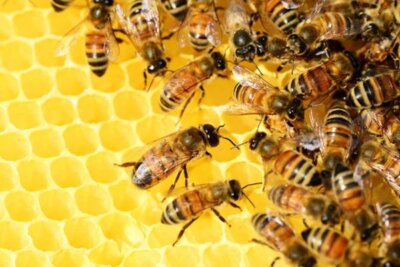
What beekeepers can do now to check if their honeybee hives risk three devastating diseases.
Honey bees are key to crop health making the vital contribution to pollination in crop production and in the natural environment.
Honey bee pollination is vital to food production and crop yield. DEFRA, The Welsh Government and Scottish Government estimate the economic benefit of honey bee pollination in the UK is estimated as £600m each year. In addition, the export value of UK natural honey was estimated £12.8 million in 2022.
Spot and Treat Viral Infections In Your Honeybees
Honeybee hives are constantly under threat from devastating infectious viruses. Unchecked, infection can go from drone to queen, queen to egg, nurse to larvae, and worker to worker.
Honeybee diseases may be high prevalence with many bees infected, high virulence with high levels of virus in individual bees or high pathogenicity where individual bees show lethal signs of disease.
There are few reliable and easy to use on-site tests for honeybee viral infections. The ‘gold standard’ polymerase chain reaction (PCR), useful even in colonies that do not show symptoms, is not a DIY option for the professional or hobbyist beekeeper.
Reliable, off the shelf and easy to use diagnostic test kits can give early warning of risks to hive health. Vetlab Supplies FASTest BEE 3T is the quick and easy three-in-one check for Deformed Wing Virus (DWV), Acute Bee Paralysis Virus (ABPV) and Sacbrood Virus (SBV) in the Honeybee.
Deformed Wing Virus (DWV)
New research from The Royal Society identifies DWV, spread through Varroa mite (Varroa destructor) infestation, as the main cause of overwintering colony death in honey bee hives. Though DWV has a global presence, where Varroa is absent or efficiently controlled there is little or no DWV infection.
Bees with shortened bodies and poorly developed or crippled-looking wings signal the presence of Deformed Wing Virus (DWV). Other signs of DWV include bees moving erratically and heaps of dead bees ejected from the hive.
In spring and summer, infected bees may die far out of sight in the field. In winter, when bees cannot fly out, the colony may die off unseen in the hive. In both cases, DWV is most easily refuted or confirmed with the real world practicality of the FASTest BEE 3T diagnostic kit.
Once present in the hive, the virus can spread in sperm from drones, eggs from the queen and by feeding mites. Research indicates that mites reduce the disease resistance of bees and larvae which allows the virus to multiply out of control.
At present, There are no treatments that act directly on the Deformed Wing Virus itself. Even if the beekeeper treats the colony and kills almost all the parasites, that may not be enough get rid of the actual virus.
Breeding virus resistant bees may be the best approach to DWV eradication. Until then, watchfulness for mites and for early DWV symptoms, together with testing for the DWV virus, may be the most worthwhile means of safeguarding your hives.
Sacbrood Virus (SBV)
Sac Brood Virus (SBV) infects and kills developing larvae in the honeycomb. Infected larvae turn from healthy white to a sickly yellow before turning dark brown or black. Worker bees often open up SBV infected cells giving a dark patchy appearance to the honeycomb.
Exposed dead larvae shrivel into dark scale-like crescents sometimes referred to as ‘gondola shaped’ or ‘Chinese Slippers’. The dead larva resembles a tough fluid-filled plastic ‘sac’ that can be removed using a pair of tweezers.
Sacbrood is caused by the Iflavirus virus which multiplies in the developing larvae. When the brood cells are capped, the diseased larvae fail to pupate. A relatively common disease in the first half of the brood season, it might affect only a small proportion of cells without resulting in severe colony damage.
Once again, it is the Varroa destructor mite that can spread this virus when feeding off honeybee larvae. Unhygienic keeper transfer of infected material, as well as feeding by nurse bees and the intrusion of ‘robber bees’, may also spread Sacbrood.
Re-queening the colony can help to reduce the impact of sacbrood virus as will reducing and controlling Varroa mite infestation. Testing dead larvae with FASTest BEE 3T may be the most efficient means of testing for Sacbrood Virus.
Acute Bee Paralysis Virus (ABPV)
Lethally mediated by Varroa mite infestation, Acute Bee Paralysis Virus (ABPV) kills adult bees, larvae and pupae. As with Deformed Wing Virus (DWV) the mite appears to suppress the infected bee’s immune response allowing the virus to multiply freely.
Heavily infected bees can spread ABPV not only to larvae in royal jelly and in pollen moistened with their saliva, but also in food shared with other adult bees. However, the principle means of infection is virus particles ‘injected’ directly into bodies of bees, larvae and pupae by feeding Varroa mites.
Varroa mites drive the rapid spread of Acute Bee Paralysis Virus throughout the hive. The virus can multiply so quickly and in so many mites that, when symptoms finally appear, it is already too late to save the hive.
Heavily infected bees show symptoms of tremor and paralysis. Many bees will die out in the field and dead larvae may be quickly removed by nurse bees. As a result, neither professional nor hobbyist beekeepers might notice the symptoms of ABPV before the entirely colony is destroyed.
Larvae that do survive become adult carriers, passing the virus to other larvae and, potentially, to many other hives. As with Deformed Wing and Sacbrood Virus, larvae and adult bees suspected of dying from Acute Bee Paralysis Virus can be most easily checked using the FASTest BEE 3T triple diagnostic test.
Business and Biosecurity Risks of Honeybee Diseases
Devastation of wild honeybees by pests and disease means that vital food crop pollination now depends heavily on commercial and hobbyist beekeepers and the health of their beehives and colonies.
Beekeepers can find more information and support from partner organisations including The British Beekeepers Association (BBKA), Bee Farmers Association (BFA), The Welsh Beekeepers’ Association (WBKA), Northern Ireland Department of Rural Affairs (DAERA), The National Bee Unit (NBU) and The Beebase Healthy Bees Plan 2030.
For more information on the quick and easy three-in-one check for Deformed Wing Virus (DWV), Acute Bee Paralysis Virus (ABPV) and Sacbrood Virus (SBV) in your honeybee hives and colonies, click this link to FASTest BEE 3T.
To find out more about our large range of veterinary diagnostic test kits visit our website: www.vetlabsupplies.co.uk or call Tel: 01798 874567

